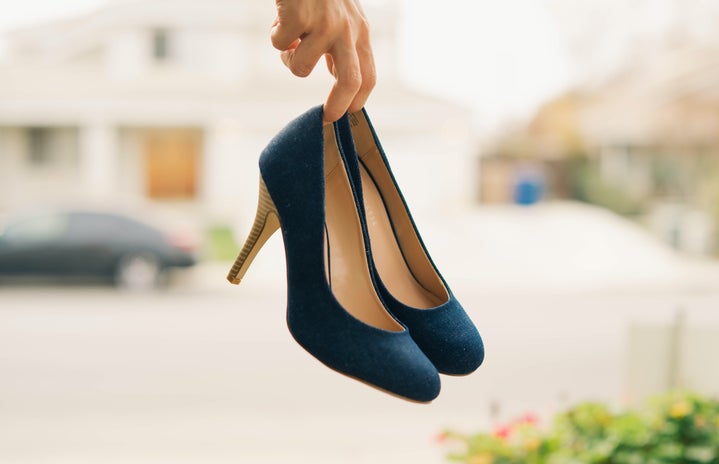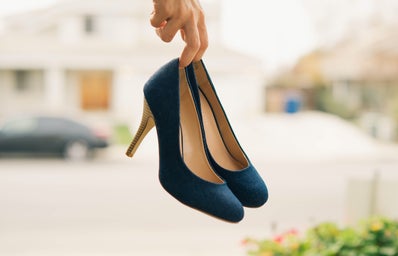She was standing in a dressing room wearing a $700 evening gown when she called us crying.
“I need to speak to Mom,” she demanded. “Now.”
In the car, I handed the phone to our mother, whose eyes would have rolled out of their sockets and onto the highway, if that was even possible. We were both used to my sister’s certain brand of over-exaggerated, not-really-an-emergency emergencies, but this time, I was on her side. I knew there was only one thing that could make my sister cry in haute couture which she happened to score for 75 percent off. My mom put her hand over the mouthpiece of the phone and turned to me.
“She doesn’t fill out her dress for the senior ball,” she whispered.
I shook my head and kicked my feet up onto the dashboard.
“And her boyfriend called her a table.”
“A table?”
“A cute table.”
Somewhere between mile markers and my disbelief that a 20-something-year-old man would call his flat-chested girlfriend a table while she was standing in the unflattering light of a consignment shop dressing room, it hit me. As someone who spent her entire life teasing the only person she’s known literally forever, why wasn’t this joke funny? Regardless of what we wear, how we wear it, or how expensive or inexpensive the dress, my twin sister and I will always be flat-chested, and that is something we cannot hide.
It started in the locker room during sixth grade, the first year that we had to change into different clothes for gym class. To me, bras were only worn by girls who had boys to take them off, like Samantha*, who insisted she went to second base behind the middle-school bleachers, and I didn’t know what she meant. My prepubescent self most certainly did not need one of those, but when I walked across that freezing cold locker room so I could change in a bathroom stall, I noticed that everyone had something I didn’t. I changed in that stall for sixth months, accumulating exactly four lunchtime detentions because it made me late for class.
I became envious of the girls whose bras peeked out of their spaghetti-strapped tank tops. They flaunted it because they knew what it meant. Obviously needing a bra meant you had breasts, but no one just had breasts. With breasts came a new uncertain sense of sexuality that I wasn’t sure I even wanted—that I, with my flat chest, still feel like I’m lacking. Most important of all, having breasts meant, with no shadow of a doubt, that you were a woman. You were the kind of girl boys whispered about in the hallway or passed notes about, scribbling down how out of their league you really were. To be flat meant you were one of the guys, a woman disguised in the body of a 13-year-old boy, invisible.
As all invisible, inexperienced girls do, I consulted my male 13-year-old cousin, who was older, female-obsessed and allegedly knowledgeable about real women—not girls like me. He frequently boasted about losing his virginity earlier in the summer, which I still don’t believe, and at 23, he still insists. I needed his male perspective.
“All girls wear bras,” he said. “You’ll get Skittle-itis if you don’t.”
Skittle-itis sounded more like something awfully contagious than what it was—when a braless girl gets cold, and it looks like she has two Skittles where her you-know-whats are. For fear of contracting a disease or drawing more attention to my already too-small chest, I asked my mom to buy me a bra. A real bra—not the cupless, underwireless piece of cloth I sometimes wore beneath my tank top so I could easily switch in and out of my gym clothes without fully exposing myself.
“What?” She exclaimed in front of my entire loud, Italian family, who are as likely to ignore something this embarrassing as they are to ignore a Yankees World Series game. “For those little mosquito bites?”
From then on, that’s what my breasts became—annoying, tiny spots that I hid underneath a double-A push-up. My bra and I were married. We slept together, spent the day together, spent the night together and only parted when I needed to shower. It was the only way I could really hide what they were.
I don’t know if it was something I truly believed, but I wished with every fiber in my being that I would wake up on my 16th birthday with a brand new pair of breasts and a closet full of 32C-sized bras—like the breast-fairy came overnight, and I no longer had to be one of the guys. Despite the fact that I was told boobs were the natural order in life, come junior year of high school, I was still waiting. My sister gave up all together and decided to be proactive.
First came the toilet paper, which she stuffed in her training bra on only one occasion, just to see what it would look like when it finally happened for us.
Second came the absurdly padded bra. The one day I borrowed it, I pulled off my shirt in the girl’s locker room, and my best friend of 11 years asked me if I really thought anyone was buying that my boobs were real. She didn’t understand. She had Ds.
The third came later, when we were in college: the infamous cutlet. Named after the same piece of chicken my mom used to fry in garlic and olive oil, my sister swore by them in any dress that needed cleavage. Newsflash: when I tried them on, still no cleavage.
Then there was the push-up bra, the water bra, the double-bra, and the Maidenform POOF! which my cousin swore gave her two whole cup sizes. It gave me zero—in fact, I swear it made me even flatter.
Then something changed in me. After years of bragging that a 32B looked bigger on me than my taller sister, like it was some kind of used car I was waiting to upgrade; after the wear and tear of donning suffocating, constricting bras in an attempt to push my barely-Bs up and away into the sky grew too much to take, I went braless for the first time in nine years. It was a backless, satin, copper-colored dress that was the first fabric to touch my girls since I could remember (other than a towel, bathing suit, or the cheap polyester/cotton blend that the only bras that ever fit me were usually made of).
That night was mine and my sister’s birthday, and we had picked out our outfits together. The dress was an impulse buy; we bought it on a street corner two blocks from her apartment where no dressing room mirrors could influence our decision. She held the fabric in her hand and fiddled with the buttons on the back.
“My roommate has this dress, you should get it,” she said. “But you definitely can’t wear a bra.”
“Does your roommate go braless?” I asked.
“She has bigger boobs,” she sighed and pushed the dress back into the rack. I scanned through some skirts until she turned to me again, “But I really sort of want it anyway.”
“So get it, as long as you don’t mind spending a night without your cutlets.”
“Every normal girl wears them, you don’t know anything,” It took her years to assure herself of that. “I can’t get it anyway. I can’t copy her.”
She turned the tag over. “It’s only ten dollars.”
After holding the dress out in front of me and picturing a much better version of myself staring back in the pretend mirror, I decided to give it a try.
That night I stood alone in my room, watching it dangle from the hanger on my dresser, trying to figure out how it could possibly be worn with my beloved push-up. Without a bra there was no padding. There was no extra lift that made my breasts look a tiny bit more substantial—it was just me. Because it’s best to dive into difficult things like you’re ripping a Band-Aid, I held my breath, dropped my towel, and put it on. I walked toward the mirror, eyes half closed, resisting potential trauma, and braced myself. I opened my eyes, and sighed in relief. What I had been avoiding for nine years wasn’t really so bad. The ground didn’t shake, I didn’t self-combust and I actually sort of liked what I saw. I couldn’t help but notice that I looked thin, tall for someone who was only 5’ 3”, and impossibly flat-chested. I was somehow perfectly proportioned in my body, which took twenty years to grow into what it was: a young woman who was no longer afraid of herself.

